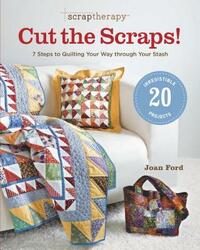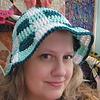Take a photo of a barcode or cover
7 reviews for:
Scraptherapy(r) Cut the Scraps!: 7 Steps to Quilting Your Way Through Your Stash
Joan Ford
7 reviews for:
Scraptherapy(r) Cut the Scraps!: 7 Steps to Quilting Your Way Through Your Stash
Joan Ford
Liked this one better than Ford's other scrap pattern book. Still don't understand her fabric choices, but the instructions for preparing sets of scraps in sizes that combine into dozens of patterns is handy and her layouts are clear. Anyone looking to get started making quilts from scraps or just that look "scrappy" could start with this book and have lots of projects to look forward to, as well as great basic skills they can apply to future projects, scrappy or not.
Some good ideas on how to make the most of your scraps. Includes several quilt projects and patterns of different levels of experience and difficulty. Pretty good directions
I am always looking for things to do with the leftover scraps from quilts. This book offers some good suggestions on cutting up your scraps to use later. I am not 100% sold on her sizes, but she did write this before pre-cuts became a huge deal in the fabric world. I have started cutting my scraps into 2.5 inch strips, 5 inch squares, and 10 inch squares only because there are so many patterns for those sizes out there now. I do like having everything cut up and labeled before starting.
My grandmother would either love this or hate this. She was a big fan of saving EVERYTHING, to the point where you really couldn't sew it in with the seam allowance, but she kept it regardless. I do not have such high standards for saving everything, but I save a lot and my stash is approaching being messily out of hand. I love this philosophy--you cut all scraps down to 2", 3.5", and 5" and then discard the rest. How easy! I really liked the first section discussing the hows and whys, though I found that more engaging than the patterns. I think that the patterns look deceptively simple, or the fabric looks outdated, so they didn't really wow me upon first sight. However, I have already started implementing this philosophy and I look forward to trying these patterns with different fabrics!
For: quilters who want to use up their stash.
Red flags: some of the fabric choices look dated now, so some new readers may not find this as visually appealing.
For: quilters who want to use up their stash.
Red flags: some of the fabric choices look dated now, so some new readers may not find this as visually appealing.
I really like the idea of cutting your scraps into standard, usable pieces (she recommends 5", 3 1/2" and 2" squares). However, the resulting quilts are too fussy and have way too many triangles for me. As another quilter has suggested, find a pattern you like and then cut your scraps to the sizes used. I'll try that - one day...
I checked out the Scraptherapy books to compare them to the Scraps Inc books. The primary difference is that these Scraptherapy books by Joan Ford use very traditional blocks and patterns, where the Scraps Inc books from Lucky Spool Media focus much more on modern designs.
Joan Ford's scrap system uses scraps in 3 sizes: 5" squares, 3.5" squares, and 2" strips. She describes a 7-step system for organizing and sewing with scraps. She does include a couple smaller projects like table runners and bags.
Joan Ford's scrap system uses scraps in 3 sizes: 5" squares, 3.5" squares, and 2" strips. She describes a 7-step system for organizing and sewing with scraps. She does include a couple smaller projects like table runners and bags.
I've been quilting since before my kids were born, so I've got scraps. By the tons. And sadly, that's not really much hyperbole. But I digress....
What I liked about this book is that it gave some real, concrete ideas for dealing with your scrap pile(s!), but also tried to keep it realistic. Joan Ford says to get rid of your teeny, tiny pieces (the smallest piece she has you cutting and keeping is a 2" square--and honestly, at this point in my life I'm not sure I really want to sew together pieces smaller than that anyway), or, if you're not ready for that yet, put them in a container, date it, and if you haven't used any of them a year later, toss it. This was...liberating. I have tendency to keep every single viable scrap--and even some not so viable--when I really don't have the room for them. But precut squares? I can handle them! The idea of having your leftover scraps already cut into usable squares, ready to go at a minute's notice was a good one too--I've already spent a few TV nights cutting up my former scrap piles, and the plastic shoebox idea keeps them much better organized than the baskets and boxes they were in before did. Joan explains her reasoning for the three sizes of squares that she recommends, and they do make sense to quilters--especially the 5" ones, since charm packs are so plentiful and inexpensive these days. I loved the idea of being able to see a pattern, grab a box of squares, and go!
As for her patterns, they did tend toward the traditional--and lots of half square triangles!--which was fine, but I'd say at this time that I'd probably make only about half of them. That's okay, though. It's nearly impossible to discover a quilt book in which every single quilt screams, "Create me!". Often it's enough just to see what other quilters have done with their fabrics and colors to give you the spark of an idea. This book definitely offered plenty to look at, think about, and do. Definitely a keeper!
What I liked about this book is that it gave some real, concrete ideas for dealing with your scrap pile(s!), but also tried to keep it realistic. Joan Ford says to get rid of your teeny, tiny pieces (the smallest piece she has you cutting and keeping is a 2" square--and honestly, at this point in my life I'm not sure I really want to sew together pieces smaller than that anyway), or, if you're not ready for that yet, put them in a container, date it, and if you haven't used any of them a year later, toss it. This was...liberating. I have tendency to keep every single viable scrap--and even some not so viable--when I really don't have the room for them. But precut squares? I can handle them! The idea of having your leftover scraps already cut into usable squares, ready to go at a minute's notice was a good one too--I've already spent a few TV nights cutting up my former scrap piles, and the plastic shoebox idea keeps them much better organized than the baskets and boxes they were in before did. Joan explains her reasoning for the three sizes of squares that she recommends, and they do make sense to quilters--especially the 5" ones, since charm packs are so plentiful and inexpensive these days. I loved the idea of being able to see a pattern, grab a box of squares, and go!
As for her patterns, they did tend toward the traditional--and lots of half square triangles!--which was fine, but I'd say at this time that I'd probably make only about half of them. That's okay, though. It's nearly impossible to discover a quilt book in which every single quilt screams, "Create me!". Often it's enough just to see what other quilters have done with their fabrics and colors to give you the spark of an idea. This book definitely offered plenty to look at, think about, and do. Definitely a keeper!


